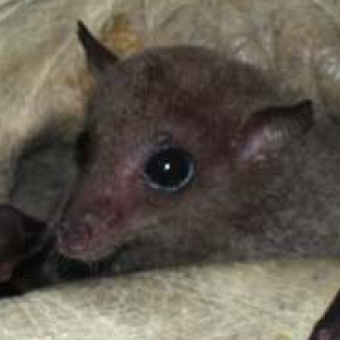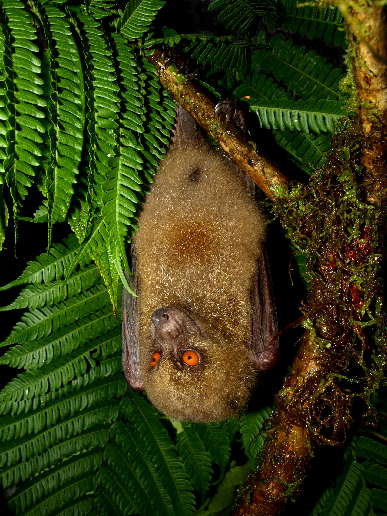Bat Conservation
Bat Conservation in Fiji
The Foundation has been working with Nature Fiji (one of the few conservation organizations in Fiji), since 2010 on conserving Fiji’s bats – both mega bats and micro (insectivorous) bats, which are endangered due to loss of roost sites and excessive cave visitation. This was triggered by a visit to Fiji by Director Hugh Spencer and his friend Monica Bianchi, they visited Wailotua cave and were horrified by the attitude of the locals to the little flying fox, Notopteris, (Fiji’s Blossom bat). The locals thought nothing of throwing stones at the bats in the cave to kill or injure them. AUSTROP funded one of their ex interns, Joanna Malotaux (from Holland) to work on developing community education material, as well as surveying the islands for other bat colonies (as their numbers appeared to be collapsing rapidly) – and for the locals they were regarded as food (even if only for ceremonial occasions). Dr Spencer joined Joanne and Kelera from Nature Fiji over Easter 2012 on a bat hunting expedition.
We are hoping to continue this association in 2014 on.
 This is the little ‘blossom bat’ This is the little ‘blossom bat’ |
From Joanna’s blog…
It’s been waaay too long since I last posted an update, so I’m going to try to cram 6 weeks worth of adventures into a 1000-word blog post… bear with me ;) This one will be a bit more focused on the work I’ve been doing here, as I’ve been on a big field trip in the last couple weeks.
Hugh Spencer arrived on Easter Monday, which marked the start of a very intensive period. For those who haven’t heard of him yet, he is the director of the Cape Tribulation Tropical Research Station, where I worked at 2 years ago during my travels through Australia. His foundation, the Austrop Foundation, is partly funding my internship here in Fiji. Hugh is a bat expert, and he came over for about two weeks to help me and Kelera out with several bat research techniques. During the first couple days we stayed on Viti Levu, surveying several batcaves, and collecting and assembling equipment for the trip to Taveuni. At the end of the week we departed for Taveuni, to search for the Fiji Flying Fox (Mirimiri acrodonta for the biologists). Taveuni is the third largest island in Fiji, and it is a beautiful place. It has lovely beaches, stunning reefs, scores of birds and a huge area of practically untouched rainforest covering its mountainous interior, with plenty of waterfalls, some even plummeting straight into the ocean. Yes, I’m positively in love with this island.
|
|
Anyway, back to business. A little bit of background information: the Fiji flying fox is one of 6 bat species in Fiji, but this is the only endemic species. It occurs only on Taveuni – as far as we know – and it has been captured (or seen) 5 times EVER. Three years ago, an Australian researcher spent 40 nights mist netting for the bat, and she caught only one individual. The Fiji Flying Fox has only been caught on top of Des Voeux Peak, the cloud-capped second highest mountain on Taveuni (1195m). The aim of our project was to see if it might also occur in lower-lying areas. Mistnetting by the way, is a technique for catching bats (or birds) – you suspend a net between two tall poles, or between two trees, you sit down, grab a drink, and wait for the bats to fly into the net.
We were planning to do several nights of mistnetting a bit further inland. However, we soon realized that we were not going to reach our objective during the limited time we had – there are barely any roads or tracks leading inland through the dense rainforest, and besides, we did not have the proper equipment, no camping gear, poles were not long enough, no ropes and slingshot, etcetera. Despite the big change of plans, the trip was quite useful. We visited two bat caves, and surveyed the small colonies of the Pacific sheath-tail bat (a small insectivorous species) that roosted there. Kelera and I also got some experience with mist netting, and we got to check out the island and make plans for further research.
And of course it wasn’t just ‘all work and no play’, we took the time to go snorkeling, hiking and swimming at the waterfalls, and the field trips weren’t bad either! We went up all the way to the top of Des Voeux Peak and were blessed with a beautiful view of the entire island – which is really rare, as it is a cloud forest, which pretty much means it’s cloudy most of the time.
Oh, and what I didn’t mention yet about Taveuni… it is the wettest place in Fiji. The village where we were staying receives on average 7 meters of rainfall anually (compare that to about 800 mm annually in the Netherlands!), while up in the mountains it’s more than 10 meters per year! We were fairly lucky that it wasn’t too wet during the first week we were in Taveuni. It often rained at night –not much fun during mist netting, although a bottle of rum makes the long wait in the pouring rain a lot more bearable! At the end of the week the downpour started, and it didn’t stop for 2 days. We estimated we had about half a meter of rain during that time! The roads were blocked and flooded, so we were stuck in the village, which was not such a bad place to be. The lodge we stayed in was located on the beach in the village. 4 hours of electricity a day, no mobile phone signal in the village, except for under a coconut tree about 100 meters further down the beach. For 10 bucks, the local ladies made you a typical local dinner – taro or cassava, fresh fish, taro leaves, all cooked in coconut milk. While it rained and rained and rained we had lots of time to write, think and discuss about the plans for the Fiji Flying Fox, and we drew up a draft research plan for a radiotracking project. Who knows, I might have the chance to come back to Fiji for that some day!
http://austrop.org.au © 1988 - 2015 - Charter - tibobruss.fr



 MiriMiri (Mirimiri acrodonta), this bat Guy Botroff
MiriMiri (Mirimiri acrodonta), this bat Guy Botroff